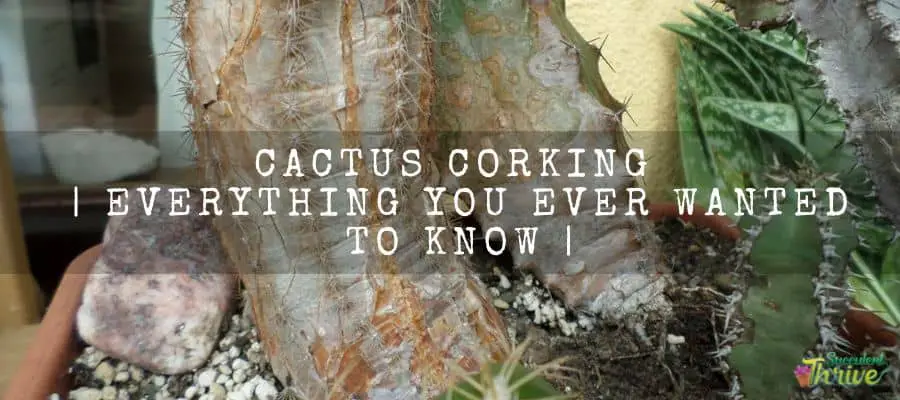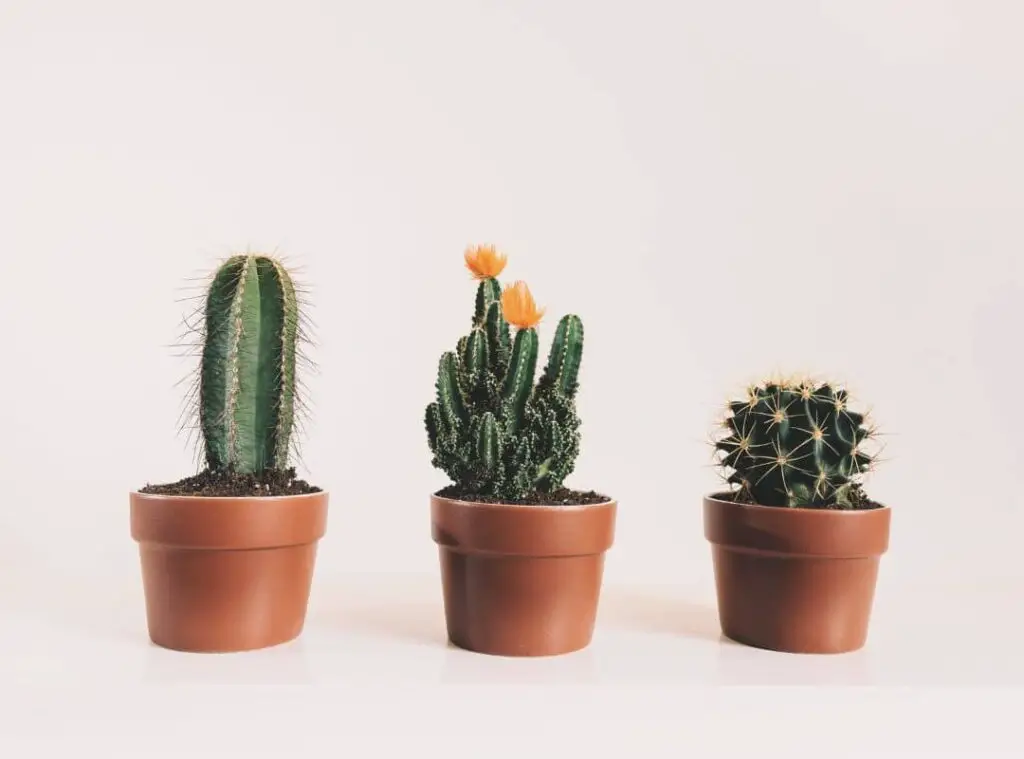Cactus corking is a natural aging process of the cacti which would impact the outlook of the plants. Keep in mind that it is not an illness or any other damage from the pests.
This is how the cactus have naturally constructed. You could identify that by the change in their color and in their texture as well.

Once the plants are going through corking, you could see how they turn brown or gray from their regular color Green. Further they would produce bumps and become rough on the surface too.
Cactus would tend to lose their sharp edges and spines as a result of cactus corking. Literally they would tend to take the surface of a sandpaper once they go through this condition.
However, they would not develop any early signs of corking yet. Further corking would take place slowly , not abruptly. Further Keep in mind that corking would not bring any lethal impact on the plants as well.
It is more like a sign that it has reached its maturity in their growth cycle. So, you do not have to be worried if you ever come across this condition. If you are a fresher into succulent gardening, you will find it alarming.
If you spot the browning has taken place only on the base of the plant, it literally means the cactus are experiencing corking.
However, if you spot browning spread on the other areas of the plants, it could be due to other issues such as issues or fungal attack. However, corking would make the plants look less appealing.
What does Cactus corking look like
Corking would usually start to form at the base of the plants. Cactus would usually start to become almost dull brown or almost dead instead of maintaining their vibrant green color.
Bear in mind that corking happens at a slow pace. So, if your cactus ‘discoloration happens all of a sudden, it could be due to some other cause and not due to corking.
Once corking tends to spread further, you could see how the texture of the plant tends to take a look at the bark of a tree.
Corking would usually start to form from the base of the plants. Corking would not occur in patches. Instead, they would tend to form in an upward manner and fairly more on around the base of the plants.
Further it would not even occur on one side of the plants too. if you come across any brown spots right on top of the plants or in multiple places, it could be due to some other reason and not due to corking.
However, chances are that corking may take place above the base of the plants depending on their maturity too. Keep in mind that not all cacti would produce corking in equal amounts.
There could be some plants which would produce corking a few inches above the soil where there could be some large cactus which would develop corking for several feet from the base of the plants.
Further many succulent enthusiasts find it difficult to differentiate sunburns with corking. If you had exposed the plants for excessive sunlight at once and if you came across these symptoms.
It could be due to sunburns. Having said that, many cacti are adapted to grow in full sunlight. However, when you cultivate them indoors or in the green houses, you need to slowly accustom them to full sunlight as unless it would lead to sunburns.
That said, sunburns would generally form as brown patches which may arise in any part of the plants and not only at the base of the plants.
Moreover, You may also check how hard and firm the discolored plant parts are.Literally if those discolored plants are hard and firm it would most probably be a sign of corking.
You could check that by simply putting a gentle pressure on those discolored spots and see whether it is firm or hard.. On the other hand if you feel like it is too soft or squishy chances are that it would be rotting.
Why is cactus corking?
As explained in the above, cactus may tend to cork as a part of their natural growth pattern. To further elaborate on this, chances are that they could become top heavy.
It would eventually make them break or fall over. As you may already know, cacti can conserve water in their foliage. That would make them top heavy as they grow.
So if their stem is not study enough to get hold of the weight of the plant , they may most probably end up falling on the ground.
So, to avoid this condition happening they would tend to develop corking as that would help them to provide some sort of stability for the plants base.
Once the corking progresses, the fiber would harden and provide some support to the plants. Eventually it would make the plants expand upwards as well as outwards.
Cacti are a slow growing set of plants in general. So, it is very unlikely that cactus would start to develop corking anytime soon.
In fact it would take so long for them to provide the aid for the hardened base of the plants. That said, we cannot state any exact age on when they will begin to cork.
There could be some exceptional cactus which would develop corking at a fairly early stage.
Further there could be some cacti which would not grow larger to the level that it could provide the extra aid to support the hardened tissue. In other words, you cannot expect all the cacti to experience the corking.
Despite the fact that the corking would take place due to the aging process, there are some environmental factors which could also cause the corking to take place.
Literally if you expose the plants for harsh sunlight levels and for excessive temperature levels it would make the plants more prone for corking.
The plants which go through less extreme conditions would not go through corking a lot compared to other plants which are exposed to extreme conditions.

How Do I Know if My Cactus Is Corking?
You could first see how they become brown , corky, and crispy once they go through this condition. Further they may also tend to lose their spines too.
It would literally make the plants look like dehydrated cacti due to exposure to extreme sunlight. As aforesaid, you could spot the corking at the base of the plants. Further it may even spread in the other parts of the plants too.
In addition to that, corked cactus would tend to take a sunken look on their surface too. Furthermore, they may also tend to take a look of a potato too.
One might think it would tend to take a shrinking shape too. Besides, the affected areas would be firm and hard when you try to touch them.
Additionally, a corked cactus would resemble the look of an old dried-up cactus too. When you try to touch the regular plants, you would feel like they are spongy whereas when you try to touch the corked plants they would be more hard and firm. Besides, Corked plants would be prominent in brown color.
How Do I Stop My Cactus Corking?
It would be somewhat difficult to overcome corking as it is an activity which happens deep inside the plants body. It is something which you cannot spot happening outside.
However, when you spot them producing a corked layer, you can snip it off so that it would stop further corking. There are certain things which you could practice preventing this from happening.
First and foremost, you need to ensure that you water them properly and allow their soil to dry out between two watering sessions.
If the plants are in a poorly aerated or poorly draining soil mix, you need to change their growing medium. Further I suggest you rotate the plants on a constant basis so that the whole plants will get sun exposure equally.
Always make sure that you place the plants somewhere where they can gain bright indirect sunlight.
Never leave them uncovered for direct sunlight as it would make the plants scorched. Refrain from placing the plants closer to drafts , or closer to heat vents as it would cause drastic changes in the humidity.
Apart from that, I urge you to use organic fertilizers to feed the cactus. Try to minimize the usage of chemical fertilizers as chances are that they may cause burns in the plants if you end up using them improperly.
Bear in mind that you cannot reverse the corking process irrespective of what you do when they start to develop. As such it is vital that you act smart and take all necessary actions to avoid this occurring. It would help the plants to grow healthily.
Is cactus corking harmful?
Corking may make the plants look less appealing and less attractive. Having said that, it doesn’t mean it could be harmful to the plants.
Corking is a natural mechanism, and it will not harm your plants. That is how they have constructed naturally and most of the cacti would go through as they get older.
There is no remedy which you could use to treat the corking. If your beloved cactus is going through this condition, all you can do is just accept them as they are.
Furthermore, each cactus may tend to develop scars and marks which are different from one another when they go through this condition.
Your plant is corking means it has lived its life and gained its maturity too. Further it means that it wants extra support to thrive too.
However if your cactus is going through this condition and if you are not willing to keep the plants as they are, you could consider propagating them.
Simply you can obtain cuttings from the plants and use them for propagation and making new plants. It would allow you to start fresh and see them flourishing from the beginning.
You may either discard the plants or share it with other friends who would not bother in having a little corked plant.
Having said that, if you spot the corking has occurred on the plants, you need to ideally observe the plants well and ascertain whether it is corking or any other issue such as pest attack or any other disease.
As aforesaid you could observe the texture and the firmness of the plants so that you could determine whether it is corking or any other issue.
Conclusion
Keep in mind that cactus corking is a permanent thing which will remain on your beloved cactus forever. This literally means you need to accept the corked plants as they are or propagate them and make new plants.
Your corked cactus would remain to be brown forever in a certain part of the plants which could possibly be around the base of the plants. It is a natural process and would not create any damage for the plants. It would only make the plants look less attractive.
Read Next : Echeveria Shaviana | An Award Winning Succulent |
